Coloring Austin’s Walls With Latino History
By Ana Paola Davila Chalita
Reporting Texas
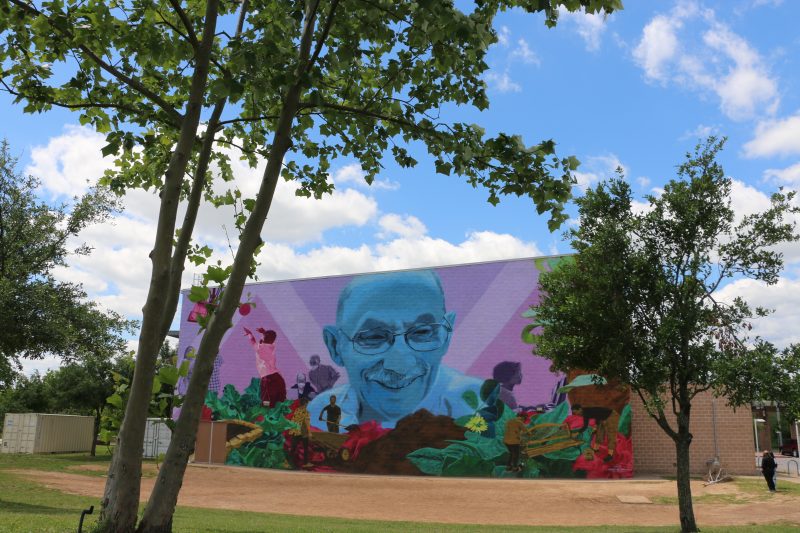
A mural depicting Gus Garcia sits on the side of the Gustavo “Gus” L. Garcia Recreation Center on April 11, 2023, in Austin. Garcia was an American civil rights attorney and the city’s first Hispanic mayor. Lauren Nelson/Reporting Texas
This spring, a new mural shines on Rundberg Lane in East Austin and honors the city’s first Hispanic Austin mayor, Gus Garcia.
It is one of dozens of murals that dot the city on the walls of buildings, parking decks, underpasses and fences — some created by non-commissioned street artists and others by professional artists funded by the city’s Art in Public Places program and by organizations such as the Austin Downtown Alliance Foundation and the Austin Parks Foundation.
Austin’s cultural diversity is represented in these vibrant artistic expressions, and the murals such as the painting of Garcia showcase the city’s Hispanic community and are an integral aspect of the city’s identity.
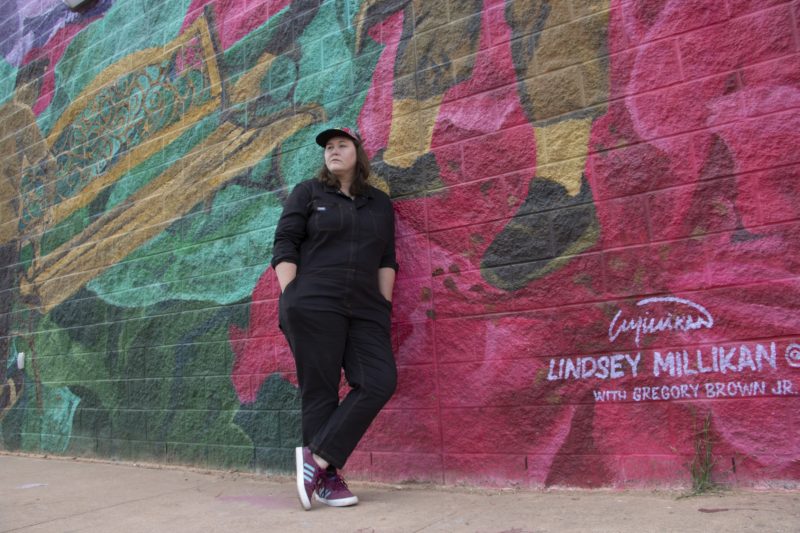
Lindsey Millikan leans on the mural she created honoring Gus Garcia. It took her nearly four months to paint and can be found on Rundberg Lane in East Austin. Lauren Nelson/Reporting Texas
The Gus Garcia mural adorns the outside of the Gustavo “Gus” L. Garcia Recreation Center which serves as a community facility offering activities for all ages, including a climbing wall, basketball courts and a computer center.
Garcia died in December 2018, and served as Austin’s mayor from 2001-2003. The mural portrays him as a “community stalwart,” Austin-based Lindsey Millikan, the mural’s creator, said.
Millikan, 37, has been painting murals for a living since 2012. Although she didn’t meet Garcia in person, she got a sense of his personality by doing research and interviewing people close to him. “Everyone really talked a lot about his kindness and presence,” she said. “Everyone refers to him as Gus, they don’t refer to him as Mayor Garcia.”
The mural was commissioned by the Art in Public Places program, which is responsible for commissioning and overseeing the installation of public art throughout the city with the goal of enhancing the city’s environment and community engagement.
Local, national and sometimes international artists can participate in the program’s “call for artists” through the program’s website. A panel of three to five experts review artist’s qualifications and ask selected contestants to come to Austin for an interview before deciding winners. Artists can only win once, which results in more opportunity for different artists.
After Millikan got selected to paint the mural, she started working on it in October 2022, and, due to weather, wasn’t able to finish until the last week of February. The big unveiling event is set to happen sometime in May.
Making people feel heard and seen is important for Millikan. Murals are a way to grant a community a “microphone,” she said. Millikan, who is a white, is appreciative of and takes seriously the opportunity to honor the Hispanic community.
The mural, Millikan said, gives “a voice” to the people using and developing the programs in the building and is meant to showcase the center’s work.
Art in Public Places paid Millikan $23,000 to create the mural, which she distributed between art materials, tools, and the salary of the person who helped her, as well as her own salary.
Constance White is the program manager for Art in Public Places. Honoring the “cultural memory” of a city is vital to instilling a sense of civic pride in residents, White said. “We’re looking back and forward at the same time.”
In 1985, Austin started allocating 1% of the costs of city construction projects, such as streets, recreation centers and parks, to funding public art. In 2004, the allocation was increased to 2%.
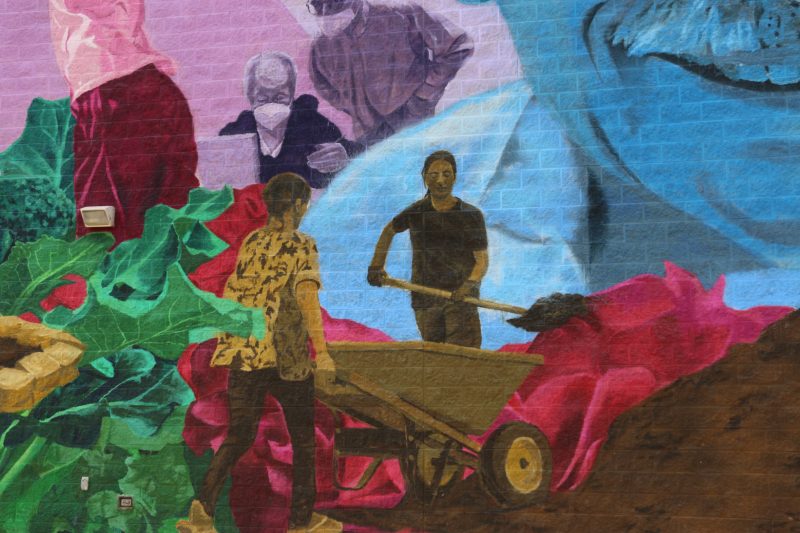
A detail of the Gus Garcia mural focuses on the importance of community, the aim of artist Lindsey Millikan who believes a mural gives voice to the people. Lauren Nelson/Reporting Texas
Art in Public Places has funded 300 pieces in the city’s public art collection, which includes murals, social sculptures, standalone mosaics and representational bronze statues. Ninety contracts to complete new art works have been awarded but not yet completed.
Being a public art administrator for 27 years, White has seen how public art can bring a community together. The Art in Public Places program aims to be as inclusive as possible, she said. “We know that equity starts with us and we take that very seriously for the work that we do.”
The language used to describe public art projects is being simplified to make it more accessible to a wider range of artists. The program is also looking to engage with the artist community by providing resources like portfolio reviews and answering any questions to help artists better understand what is expected of them, White said.
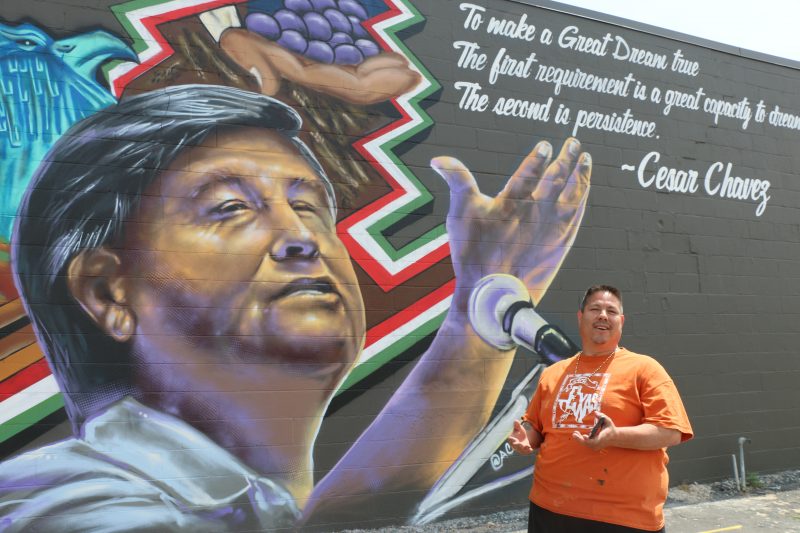
Armando Martinez explains the significance of the mural he and other artists painted honoring civil rights and labor leader Cesar Chavez. It resides on East Cesar Chavez Street in Austin. Lauren Nelson/Reporting Texas
.
In January, a group of muralists known as Arte Texas, painted a mural commemorating another Latino champion — American labor leader and civil rights activist Cesar Chavez.
Arte Texas is a group of muralists from East Austin who first came together when they restored the La Loteria mural — a celebrated 1st St. East Austin mural which was covered in 2015 for a South by Southwest event.
Today they are working on restoring older Chicano murals around town, as well as creating new ones, such as the Cesar Chavez mural at East Cesar Chavez St.
“This mural is telling everything that he fought for,” Armando Martinez, one of the artists in Arte Texas, said. The mural, which took four days to finish and was done by mid-January, has everything that Chavez fought for.
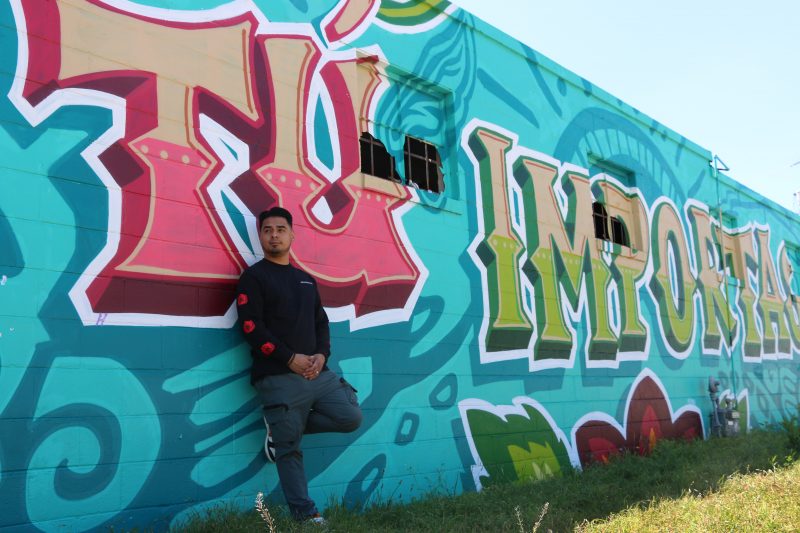
Felix Jaimes, aka Snuk One, leans against his South Congress mural, “Tu Importas,” which translates to “You matter.” Lauren Nelson/Reporting Texas
The mural “Tu Importas,” by Snuk One, a 34-year old Austin muralist, was painted in 2021 on an empty, one-story brick building formerly the home of McCoy’s Lawn store. The mural was commissioned by several mental health non-profit organizations.
It is painted in green and pink bubble letters across a sea green backdrop, as the words, “Tu Importas,” “you matter” in Spanish, welcome passersby on South Congress Avenue.
“It is intended to help break the stigma of mental health in the Latino community. Let the community know that it is ‘okay not to be okay,’” Snuk One, whose given name is Felix Jaimes, said.
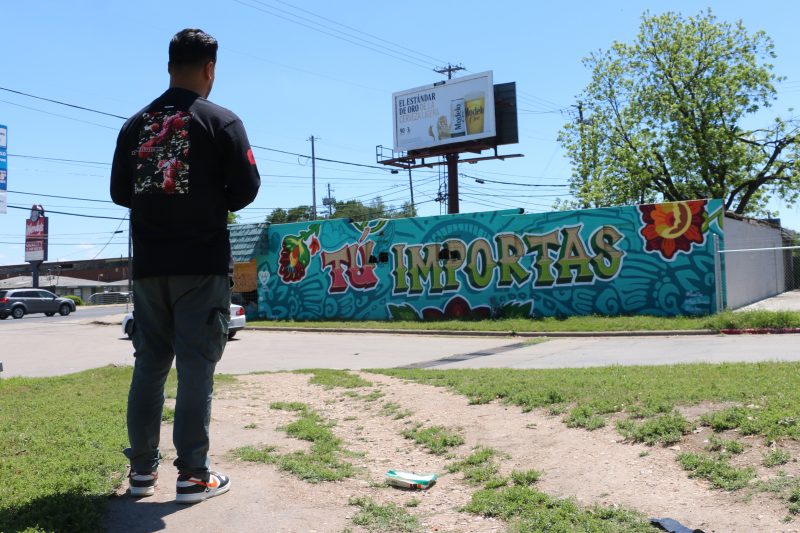
Artist Felix Jaimes, aka, Snuk One, stands before the “Tu Importas” mural he created. His intent was to encourage members of the Latino community to speak about mental health issues. Lauren Nelson/Reporting Texas
“There is a stereotype in the Latino community which impedes people from talking out loud about mental health issues,” Jaimes said. “There is just so much that we can take before we start to break, so it is okay to speak out and take care of yourself mentally, and that was the message.”
Cary Cordova, a Latino studies and art history professor at the University of Texas at Austin, says murals are an accessible and affordable art that can have a powerful impact in a community, because of their size and placement in visible locations around the city. Artists want to create art that can speak to a community, and can be opportunities to mark history when that history is not being represented elsewhere, she added.
“Murals have become spaces to demand justice,” she said.